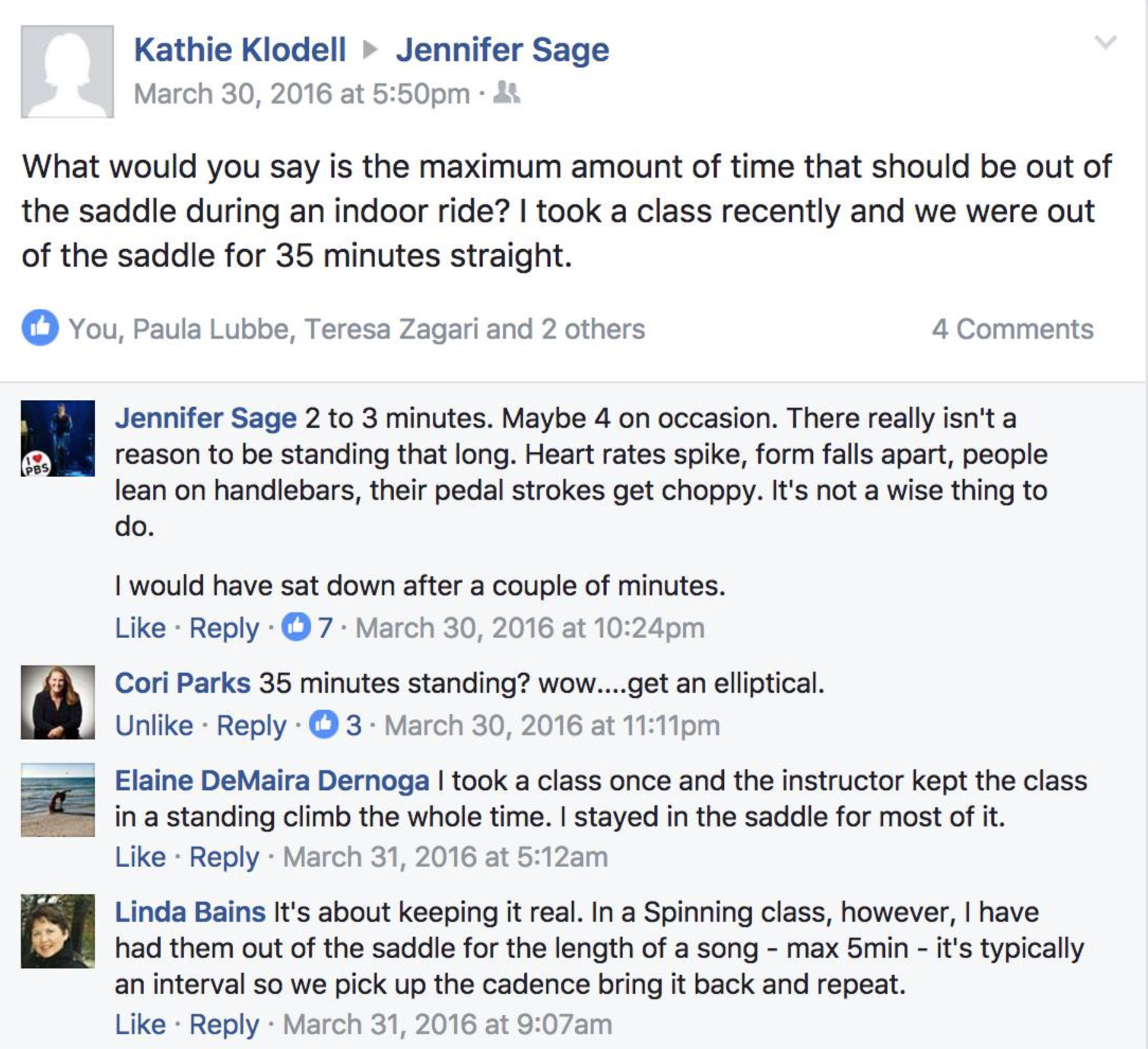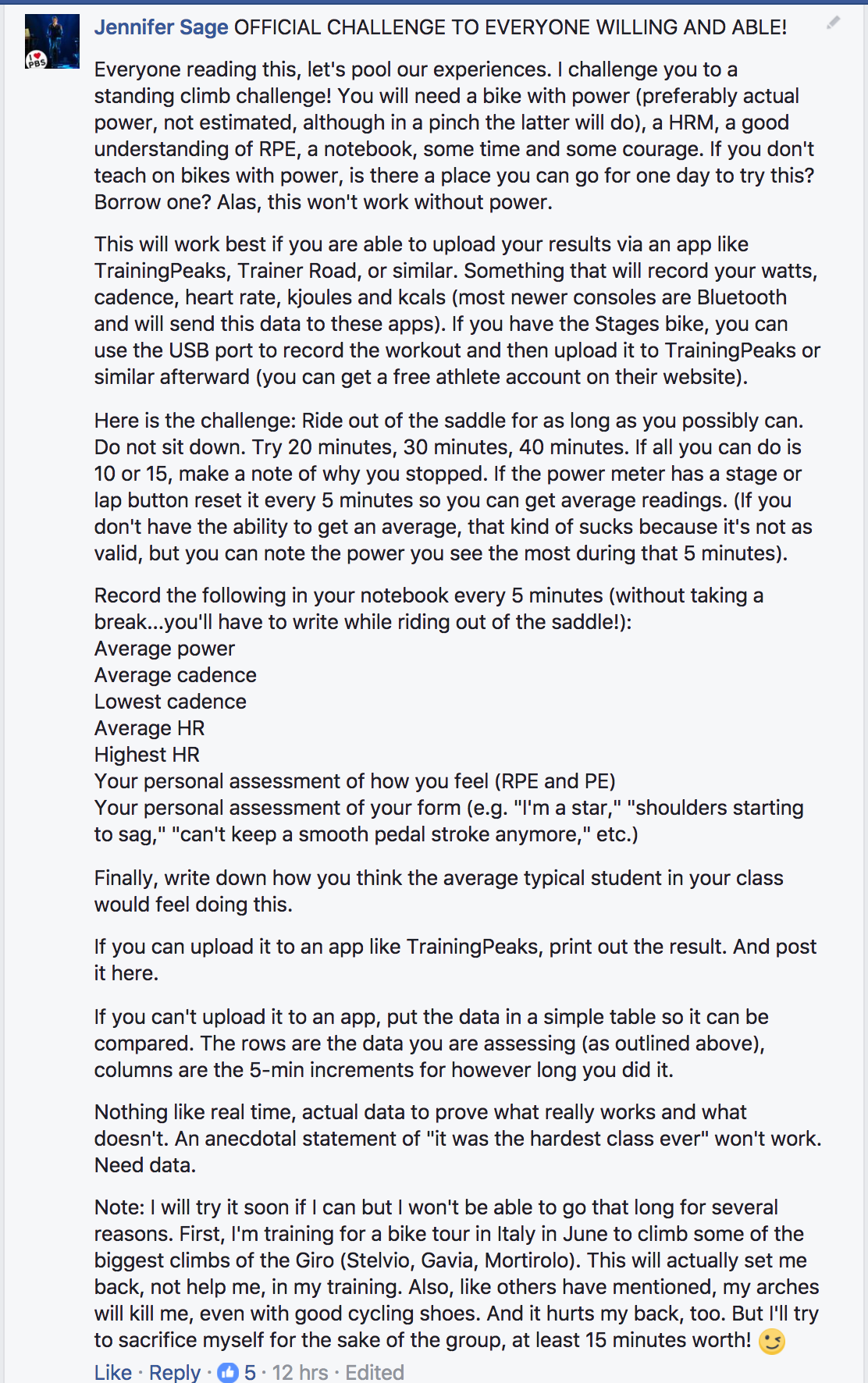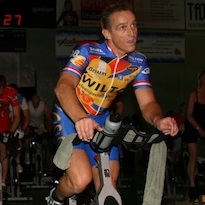Today in one of the online forums on Facebook, an instructor told the story of leading a class while out of the saddle the entire time for his “seasoned veterans.” He did a 40-minute “standing climb.” I’ve been a member of most of the online forums since their inception and was part of the very first online Spinning forum that started in 1999. I’ve seen claims (boasts) like these ever since then, as well as questions from instructors asking what should be the longest amount of time you spend out of the saddle.
I’ve seen a YouTube video posted by one instructor of his entire class with 40 minutes of nothing but standing.
Well, the answer depends on many things. First and foremost is fitness, followed closely by proper technique. Newer riders will find their heart rate soars at merely the thought of standing up, but as they gain confidence and fitness and learn the proper technique, they can stay up for longer periods. Thirty seconds at first, then 1 minute, then maybe 2 minutes. More experienced riders can stand for longer, but in an indoor cycling class, there really is no purpose for keeping your class out of the saddle for longer than, say, 5–7 minutes.
My response on the Facebook post on standing the entire 40 minutes was the following:
The longest I will stand is a few minutes. There are better ways to create challenge. The longer you stand, cadence will likely drop (50s, 40s, or for some, even lower), as will power, but heart rate will skyrocket. Cycling coaches recognize that higher heart rates for a similar or lower power is a sign of inefficiency. Heart rate is the “cost” of the effort. Are you spending more to do the same thing? Rethink what you’re doing.
And most certainly, form will fall apart. Even the “strongest” riders’ form will decline, although some may be able to go longer than others before that happens. Ten minutes maybe.
Alberto Contador is a pro rider who is known for his ability to stand for longer periods on climbs in the Tour de France and other races. He is beautiful to watch. He would never do this either.
I do not know any master instructor from any of the reputable indoor cycling programs who would suggest standing this long. There is a reason that it is included in the Spinning contraindications workshop, and the e-book “Keep it Real.”
I once saw an article in a newspaper in a southern state about a guy who was “training” for the Mount Washington climb in NH, one of the hardest climbs/events in the cycling world. How was he “training”? By taking the seat off the Spin bike at his club and riding for long periods.
This violates so many training principles such as specificity and functionality, not to mention the bit about inefficiency I posted above (HR as the “cost” of the effort). But the biggest one it violated was the word TRAINING. I mean, it’s like saying, “What can I do that will most sabotage my efforts to be better at this event I want to do?”
Video of rider in a standing climb
An instructor shared this video of a rider in a cycling class out of the saddle. She said this was at about the 4-minute mark. You can see the cadence is exceedingly low (I counted about 38 rpm). This is VERY common, especially when fatigue sets in. This person’s power output would have dropped significantly. Similar to someone on a StairMaster who is leaning on the handrails, this rider has to lean on the handlebars and position her hips over the downward moving pedals. That way she uses her body weight more than muscle contraction to turn the pedals. In other words, she is getting very little benefit from this technique.
You know how Facebook shows you memories from past years? Very coincidentally, just after I saw the Facebook post mentioned above, I saw a post in my memories where someone had asked me about standing. I had to look at the date to confirm it was exactly one year before. Here was that conversation:

But my riders aren’t cyclists! They don’t care about power!
The most common arguments given by instructors who like to stand for long periods is that their riders aren’t cyclists and they don’t care about power output. One poster said:
I note that an average rider does not care about power output and the like and reasons for doing certain rides. As long as they are burning a few calories and having fun then I say why not?
My response (edited for brevity) was:
Let me ask you a question. If you aren’t wearing a heart rate monitor, is your heart still beating?
Of course. It’s the same with power…even if you don’t have a power meter, you are still putting out power (or negatively affecting your power output, as in this case). Therefore, instructors absolutely should understand what techniques negatively affect power output even if they will never teach with power meters. Because guess what is more closely related to power output than to HR?
Calories.
Instructors who finally get this are blown away; it’s like a lightbulb moment for them. They say, “You mean all this time I’ve been overly fatiguing my riders but not actually doing much to help them? You mean those techniques that seem so ‘hard’ actually burn fewer calories, not more?”
This kind of transformation in instructors is when instruction across the board improves and the indoor cycling industry has more credibility.
And always remember, sticking to scientifically sound training principles in everything you do in no way at all precludes it from being fun. The fun is the icing on the cake—the music, the coaching, and a cleverly designed profile that still sticks to proper training and cycling principles. The latter is the cake itself.
What does the science say?
This article in the UK’s Cyclist magazine has a great description of the science behind standing versus seated.
In 2008, Professor Ernst Hansen discovered that road cyclists were better off remaining seated until the gradient hit 10%. From then on standing became more effective in terms of sustained power output, although the riders consumed 5% more oxygen when standing. During short (less than 30 seconds) all-out bursts, peak power output has been measured at 25% greater when standing compared to sitting, but there is trade off. Research has shown that even at shallower gradients of around 4%, ascending at 19kmh while seated requires 10% less oxygen than when standing. That’s primarily because the body’s centre of mass is supported by the saddle, conserving energy.
One rider quoted in the article says he keeps his standing periods to a minute or less:
“In general, I’ll only stand up on steep sections—around 10% plus,” says Tejvan Pettinger, winner of the 2013 British Hill Climbing Championships, “though standing up is more tiring so usually this is left to below 60-second bouts.”
Yes, there are pro cyclists who seem to stand a lot. Alberto Contador comes to mind. He’s a small-framed rider who excels in the mountains and his style is to “dance on the pedals” (said in my best Phil Liggett voice). Other pros only stand when they need a surge of power. It’s partially style and training, but it’s largely body size. Nevertheless, aside from a few exceptions such as Contador, Chris Horner, and Lance Armstrong, by and large, many cyclists avoid long periods out of the saddle, save for attacks or a final drive to a summit finish. Why? Because standing consumes more oxygen and therefore induces greater fatigue. Power will increase initially, but this greater output cannot be maintained for long.
Alberto Contador has said he will spend as long as 20 minutes out of the saddle during his training rides. But Contador is no mere mortal, and it would be folly for anyone (especially someone without the skill and experience that he has) to try to emulate him unless they could put out the amount of wattage that he can while climbing (350–400 watts).
There’s a wide range of preferences for recreational riders. For me personally, I don’t stand much because it spikes my heart rate. I live in the Rocky Mountains surrounded by big climbs that we tackle every summer, and I’ve also had the great fortune to be able to ride some of the biggest and most famous climbs in France, Italy, and New Zealand. On a 2+-hour climb, I might stand for a grand total of 5–10 minutes, in 30- to 60-second bouts. On steeper grades, I’ll stand a bit more. While I do have some cycling friends who stand much more often than I do (and do it well), I believe I am more the norm.
THE CHALLENGE!
I recognize that I probably won’t change the mind of the person who posted his 40-minute standing climb, nor will I convince a few who commented about “fun,” “calories,” or not caring about power or cycling, who think their riders are “seasoned veterans” who can ride out of the saddle for 40 minutes no problem. But I do hope to educate some of the instructors who read these posts and do not comment, who might be seeking answers to become better instructors, or who might be swayed by the glitter of “fun” over technique. (Note: I’m happy to say the vast majority of the posters on this thread agreed that standing for that long was ineffective, greatly reduced power output, and caused poor form.)
However, the single best way to learn is to do it yourself.
Therefore, I have created a challenge that I want to put out to everyone reading this. I call on you to try this with me. We need data. Doing this without a power meter and heart rate monitor won’t provide any meaningful information, so don’t bother unless you have power. You don’t need to know a lot about power to do it, though I assure you, you will know a lot more when you are done! 😉
I am going to create a video explaining this in more detail, but in the meantime, start thinking about whether you want to be a part of the challenge. I will gather the results and compile them by the end of April.
Here is the challenge…I hope you’ll join me! Leave a comment if you have any questions.

NOTE: A few months after this post, I created a second standing climb challenge that may be even more helpful. Instead of standing for as long as you can, it requires comparing power output and heart rate for 5-minue standing and seated efforts. Both that challenge as well as this one are enlightening and worthwhile for understanding how your body reacts to a continued standing position over time. Do these challenges on your own and not with your students—they are to help you as an instructor so you are wiser in your terrain choices.
You can find that second challenge here.
I would love to know if you did either one of these challenges—please let us know in the comments!


http://gph.is/KmRsQ1
/var/folders/kn/7fh9gths2wb0cnc52wtwcll80000gn/T/com.apple.Preview/com.apple.Preview.PasteboardItems/cowboy-1 (dragged).tiff
I’ve been using a Kinetic Road Machine Smart Bike Trainer daily for a month now. I warm up with slow cycling for 5 minutes, ride standing for 30 minutes, and cool down with slow cycling for 5 minutes.
This is my only experience with cycling and cardio. I started this because I thought it would be less impact on my joints than running.
This is the first I’ve read of proper form, heart rate, or pedal strokes. I assume my form is bad. Is it likely that I’m hurting my knees, back, heart, or risking repetitive stress injury?
Hi John,
you are right; cycling is much less stressful on the joints than running.
I’ve got a couple of suggestions for you, I hope that’s ok!
First, when you say you warm up with “slow cycling,” do you mean slow cadence? Do you have a cadence meter? I would warm-up with quicker cadence, above 80 rpm and even into the 90s if you can. Or at least, do a few leg surges from 80 to 90/95 for 30 seconds each. This will help warm your legs and heart much better.
Then limit your standing. If you had a power meter, as explained in the article, you would see that you probably put out much less power standing for long periods than you would if you were seated. A few standing segments here and there to stretch the legs and give the back end a break are fine.
I don’t think you’ll injure yourself, except it’s a lot harder on the back to stand for long periods like that. It takes a lot of core strength. Do you work your core in other workouts (off the bike)? The biggest thing is that it’s less efficient and by putting out less power, you are not getting the workout you should or could be getting. More power translates to greater fitness. Greater fitness means you’ll burn more calories, have greater endurance, and will be stronger.
Even if you don’t have a power meter, you should train as IF you had one.
What do you use to help you focus when you ride, any kind of app? Or music? Or watch a movie?
I can recommend the Sufferfest App to help you as you ride. You can also check out Zwift and TrainerRoad.
Hope that helps! Have fun……and sit down! 😉
my longest time standing on a spin bike was 3hours 33 minutes and 33 seconds .I quite often did 3hours every 2 to3 days.it made me strong and fast.not recommending it just stating what I did.was aged 65 at the time.now at 72 still do it for an hour or so.
I would be very curious to see your power data. It’s the only objective metric there is. Not your heart rate, or your “perceived” effort or fitness, but power. You might be very surprised.
love reading all this thanks again for validating what i teach!
I have said this for years So glad to validate my thoughts. Have been teaching spin for 14 years.
Thanks for posting this article. I have been in classes where excessive standing and fatigue occurred. As an instructor it seems more and more I am fitting new riders to their bikes and discussing the basics to help them feel comfortable and get started and engaged. We have a responsibility to help everyone enjoy the class and be safe. Our classes at the Y involve all age groups. I want to thank Jennifer and the staff for their continued excellent guidance and efforts with ICA. This site has helped me deliver fun challenging rides with great music to assist my classes in achieving their goals.
Thanks for all you do and your passion for keeping it real.
Count me in!!! I’ll do it tomorrow on a Stages bike and send you the data! This sounds AWFUL by the way but I’ll do it for science!
thank you! Can’t wait to see the results!
Should I have you sign a waiver?? 😉
Just looking at the short video clip displays the poor form; the undulating of the body which could also mean that there’s too much resistance not just fatigue. Additionally, look at the arm position, elbows are stuck out to the side because this participant is unable to hold proper form.
I’ve never done more than a seven minute standing climb simply because there is no purpose, and as pointed out, the form goes to pot around the 3.5 minute mark with the leaning on the handle bars which just makes me nuts.
There are more effective ways to ‘kick butt’ which Jennifer et al., have pointed out time and time again.
Personally my body generates 10-15% more power when seated. There would be a natural variation in our participants however none would benefit from such a long standing climb. Most of the standing components of my climbs would be around 1 minute or less with the climb either completed or switching to seated climb
I think everyone can put out a higher power output while standing for a SHORT period (attack, surge, etc) but the longer the duration, seated will win overall. Except perhaps those unique pro riders noted in the article (Contador, Armstrong, etc)! 😉
I have Star 3 and Power Mad Dogg certifications and I find this extended standing nonsense to fall under the broad category of cruel and unusual punishment as well as violating the goal of not creating a workout that most of your students will not be able to complete. MERE HOGWASH. Thank You, I feel better now………
“cruel and unusual punishment”! Yup! That’s what it is!
well – at WSSC this year there will be a 40min standing flat session…
GULP!!! No way!
I dare them to do it on the bikes with power and to record the data and plot it. And to video everyone doing it.
Brigitte, I’ve signed up for the conference but didn’t see this Workshop (not that I’d take it). Who is the presenter and on what day and time?
It’s called Run Time: 40 Minutes
Martin Timmerman
June 2 at 11:15–12:30.
Description: “Take it or leave it!” as the expression goes. “Learn, make and do” is the motto of this Spinning session. Challenge yourself with a 40-minute Standing Flat.